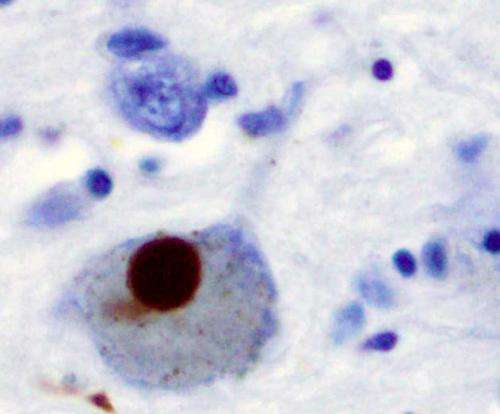Modeling brain connections to understand Parkinson's disease

Some 10 million people worldwide suffer from Parkinson's disease—a debilitating condition that causes degeneration of brain nerve cells that control movement. The exact reasons for this degeneration remain unknown. A study published in open-access journal Frontiers in Computational Neuroscience uses a new approach to model the strength of connections within the brain's basal ganglia. Determining how these differ between healthy and Parkinsonian patients could help scientists understand why individual brains malfunction—and lead to customized therapies specific to the particular pattern of neural degeneration in an individual Parkinson's sufferer.
Basal ganglia: malfunction causes Parkinson's
The basal ganglia are a system of neuron clusters, or nuclei, connected to each other and to many other parts of the brain. These ganglia are associated with a number of functions including control of voluntary movements, procedural learning, and habit formation, and their dysfunction leads to neurological disorders such as Parkinson's disease and Tourette's syndrome.
"The brain is a complicated organ with many interconnecting systems. At its center, the basal ganglia is one of its most interesting and interconnected regions. Improved experimental methods are now enabling us to discover more about it, revealing the great complexity of the basal ganglia," says Abigail Morrison of the Institute of Neuroscience and Medicine, Jülich Research Center, Germany.
Every brain is different
Scientists can examine physical connections within the basal ganglia, but many knowledge gaps remain about their strength.
"We need to understand how the strength of connections in the brain's basal ganglia change when someone develops Parkinson's disease," says Morrison. "It's also important to remember that every brain is different—what is true for one Parkinsonian patient might not be true for another."
To understand what's going on in an individual brain, the team devised a way to model this variability. They hope this can be used to develop a computational approach that is complementary to clinical practice. This could lead to the creation of customized therapies, specific to the particular pattern of neural degeneration in an individual Parkinson's sufferer.
Genetic algorithm helps understand neural connections
There are two main obstacles to accurate modelling of the basal ganglia: the lack of reliable data describing the strength of these connections, and the large variability between subjects. To take these into account, the team decided to generate the parameters for their basal ganglia model using a genetic algorithm.
Genetic algorithms are based on natural selection processes that mimic evolution. In nature, a bird with a harder beak has an advantage foraging for insects in the bark of a tree, and so has a higher probability of reproducing. After many generations, this process can ultimately result in a woodpecker. Analogously, in a genetic algorithm, large numbers of potential solutions are generated, combined, and adapted, until a desired genetic product is reached.
"We turned to the genetic algorithm to generate connections between the nuclei and their strengths computationally. This allowed us to make lots of different network configurations that represent different possible brain connections in individuals," explains co-author Jyotika Bahuguna.
The team used electrophysiological data from rat brains as criteria for healthy and Parkinsonian conditions. The genetic algorithm generated more than 1,000 possible configurations for the activity occurring in each condition, which were then analyzed for both groups.
"The approach is similar to a weather forecasting technique where predictions for a variety of weather systems are made using different initial configurations of weather conditions," explains Morrison.
A tool to understand Parkinson's progression?
The team found a broad overlap between the strength of individual neural connections in healthy and Parkinsonian brains. However, when they looked at the global network activity in response to stimulus, it was easy to determine whether a network configuration was healthy or Parkinsonian. A detailed analysis of these networks, especially the ones which lie on the boundaries between healthy and diseased, might shed light on how a brain transitions from a healthy to a Parkinsonian state. More importantly, it could help identify therapeutically feasible options that would allow transition from a Parkinsonian state back to a healthy state.
"It is important to realize that Parkinson's disease is dynamic. We have a stylized picture of the effects of neurodegeneration, but we need to remember that the patterns of degeneration are variable and are different in each individual," concludes Morrison.
"Future clinical approaches incorporating computational methods could incorporate the variability present among the patients. This would allow treatment to be customized to compensate for the specific pattern of degeneration exhibited by a patient, to try to restore healthy dynamics."
More information: Jyotika Bahuguna et al, Homologous Basal Ganglia Network Models in Physiological and Parkinsonian Conditions, Frontiers in Computational Neuroscience (2017). DOI: 10.3389/fncom.2017.00079



















